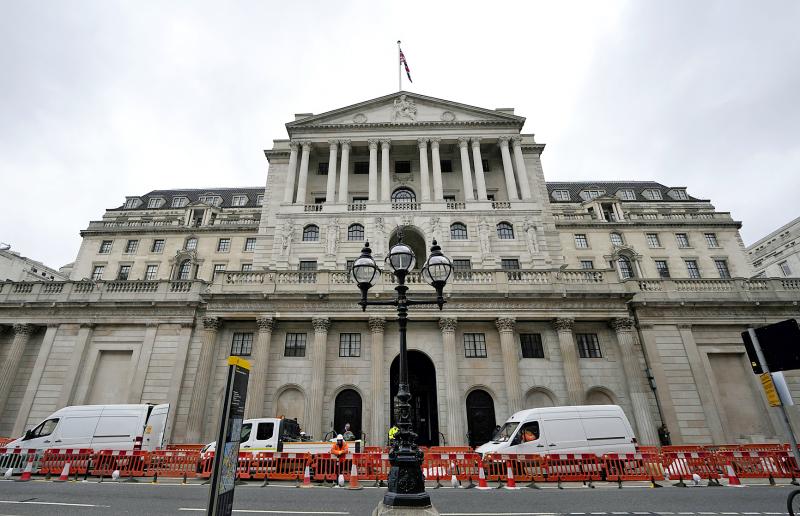High above the Bank of England, a weather vane tracking the wind direction connects directly to a dial in the stately building’s Court Room. In the 1800s, the bank’s directors met there and knowing which way the wind was blowing was crucial. An easterly breeze meant that ships, loaded with commodities such as copper and wheat, would be sailing up the Thames River to offload their cargo, affecting demand for money in the City of London. Westerly winds meant the opposite.
The weather vane is still there, but central banks have largely lost their mastery over the link between commodity markets and monetary policy. With booming raw materials markets driving the fastest inflation in decades, that is a big problem. As a result, forecasting inflation this year has become more art than science. What would be the Saudi Arabian king’s response to US pressure to boost oil production? What is Russian President Vladimir Putin going to do with Europe’s gas supply? How will Beijing react to record-high coal prices?
Perhaps that is beyond the expertise of any central banker. Instead, most of them rely on rather unsophisticated tools to incorporate commodity markets into their models. Worst is their mechanical use of the futures curve for inflation forecasting. The futures curve is not a forecast of where commodity prices are heading, but rather a snapshot of what the market is willing to pay today for delivery in the future.

Photo: AP
That is one of the reasons that the US Federal Reserve, the European Central Bank and others got inflation wrong last year. They assumed, looking at the shape of the price curves, that the worst of the commodity price increases were behind them. Inflation, therefore, was “transitory.”
Wrong. Central banks themselves are aware of the shortcoming. In 2012, the Bank of England published a paper about its troubles incorporating oil prices into its inflation modeling: “Despite the theoretical link between the futures curve and expected spot prices, the futures curve has not been a very good guide to predicting future spot prices, failing to predict the upwards trend in prices between 2003 and 2008 as well as the collapse and recovery in oil prices since then.”
Yet, in the very same study, the authors argued that the bank should continue using the futures curve for its forecasts. One reason? It is easier.
Today, the Bank of England assumes that, for the first six months of this year, energy prices would follow the futures curve, and after that stay constant.
In a tight market, as we have today, the shape of the futures curve is particularly misleading as a forecast. Take oil: The curve today is a steep downward slope — something called backwardation. That shape means buyers are willing to pay a premium for scarce barrels for immediate delivery.
However, the downward slope does not mean that oil prices are due to fall. It is just an indication of present demand.
For the Brent oil market, the price difference between the contract for delivery in April and the forward contract for December is US$10 a barrel. A central bank might interpret that as a sign that Brent crude is due to drop from US$95 to US$85 a barrel from now to the end of the year, a harbinger of weaker inflation.
Ask any physical commodity trader and they will tell you how wrong that is. If central banks require a mechanical way to incorporate commodity price futures into their thinking, the options market offers a better alternative: The price difference between bullish and bearish options contracts — known as the put-call skew in the jargon — gives a better sense of what the market thinks is the balance of price risk. The options market right now is signaling that, on balance, prices might be higher in the future, not lower.
Which brings us back to the question of expertise.
The major central banks have legions of economists who honed their chops in an era of unconventional policy: negative interest rates and quantitative easing. The focus of inflation modeling this century has been centered on prices excluding food and energy, removing the economy’s volatile elements. That is precisely the opposite of what we need now. Mathematical modeling of the latest economic theory might have its uses, but simple commodity demand exceeding supply does not need extra bandwidth — it needs experienced eyes and ears on the ground.
Central bankers need intelligence about commodity markets. Outside the Fed, which has a network in the oil and agricultural industries thanks to its regional banks in Kansas City, Missouri, and Dallas, Texas, few other central banks knows much about what is really going on in energy, metals and agricultural markets.
If they want to get inflation right this year, central bankers should abandon their complex mathematical models and ask oil companies, miners and farmers what is going on. They are likely to be surprised.
Javier Blas is a Bloomberg Opinion columnist covering energy and commodities. He was previously commodities editor at the Financial Times and is the coauthor of The World for Sale: Money, Power, and the Traders Who Barter the Earth’s Resources. Marcus Ashworth is a Bloomberg Opinion columnist covering European markets. He spent three decades in the banking industry, most recently as chief markets strategist at Haitong Securities in London.
This column does not necessarily reflect the opinion of the editorial board or Bloomberg LP and its owners.

‘SWASTICAR’: Tesla CEO Elon Musk’s close association with Donald Trump has prompted opponents to brand him a ‘Nazi’ and resulted in a dramatic drop in sales Demonstrators descended on Tesla Inc dealerships across the US, and in Europe and Canada on Saturday to protest company chief Elon Musk, who has amassed extraordinary power as a top adviser to US President Donald Trump. Waving signs with messages such as “Musk is stealing our money” and “Reclaim our country,” the protests largely took place peacefully following fiery episodes of vandalism on Tesla vehicles, dealerships and other facilities in recent weeks that US officials have denounced as terrorism. Hundreds rallied on Saturday outside the Tesla dealership in Manhattan. Some blasted Musk, the world’s richest man, while others demanded the shuttering of his

ADVERSARIES: The new list includes 11 entities in China and one in Taiwan, which is a local branch of Chinese cloud computing firm Inspur Group The US added dozens of entities to a trade blacklist on Tuesday, the US Department of Commerce said, in part to disrupt Beijing’s artificial intelligence (AI) and advanced computing capabilities. The action affects 80 entities from countries including China, the United Arab Emirates and Iran, with the commerce department citing their “activities contrary to US national security and foreign policy.” Those added to the “entity list” are restricted from obtaining US items and technologies without government authorization. “We will not allow adversaries to exploit American technology to bolster their own militaries and threaten American lives,” US Secretary of Commerce Howard Lutnick said. The entities

Minister of Finance Chuang Tsui-yun (莊翠雲) yesterday told lawmakers that she “would not speculate,” but a “response plan” has been prepared in case Taiwan is targeted by US President Donald Trump’s reciprocal tariffs, which are to be announced on Wednesday next week. The Trump administration, including US Secretary of the Treasury Scott Bessent, has said that much of the proposed reciprocal tariffs would focus on the 15 countries that have the highest trade surpluses with the US. Bessent has referred to those countries as the “dirty 15,” but has not named them. Last year, Taiwan’s US$73.9 billion trade surplus with the US

Prices of gasoline and diesel products at domestic gas stations are to fall NT$0.2 and NT$0.1 per liter respectively this week, even though international crude oil prices rose last week, CPC Corp, Taiwan (台灣中油) and Formosa Petrochemical Corp (台塑石化) said yesterday. International crude oil prices continued rising last week, as the US Energy Information Administration reported a larger-than-expected drop in US commercial crude oil inventories, CPC said in a statement. Based on the company’s floating oil price formula, the cost of crude oil rose 2.38 percent last week from a week earlier, it said. News that US President Donald Trump plans a “secondary